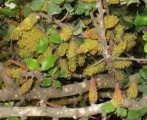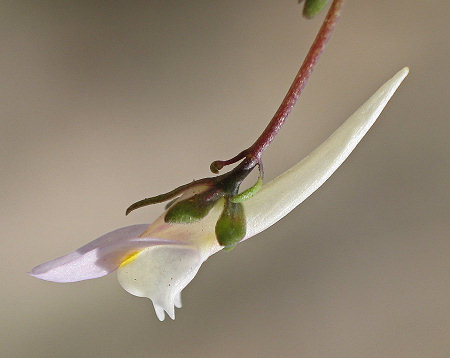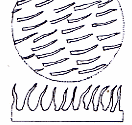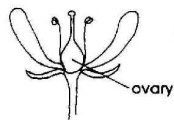| |
|
 | |
| MaltaWildPlants.com by Stephen Mifsud |

|
| |
|
|
 |  |  |  |
| External Links: |
|
Linaria pseudolaxiflora (Maltese Toadflax) |

Linaria pseudolaxiflora (PLANTAGINACEAE.)
Images for this profile are taken from the Maltese Islands after year 2000. |
|
| Nomenclature |
Species name : | Linaria pseudolaxiflora Lojac. | Authority : | Michele Lojacono, Italy, (1853 - 1919) | Synonyms :
(basionym or principal syn.) |
|
Plant Family : | | English name(s) : | Maltese Toadflax | Maltese name(s) : | Papoċċi ta' Malta, Xetbet l-Art Maltija | Status for Malta : | Subendemic. Found in Malta and neighbouring territories such as in Sicily,
Lampedusa, Pantelleria, and other islands. | Name Derivation : |
Linaria: "From the Latin ""linum"" which means flax, referring to the resemblance of leaves of many species to the flax plant ". (Latin origin ); 2 = from the Latin "linum" which means flax, referring to the flax-like leaves of some species. (Latin);.
pseudolaxiflora: Reference to close resemblance to the species Linaria laxiflora where the connotation pseudo , meaning false, is used to indicate that it looks but is not that plant. (Latin origin ); 2 = "pseudo" = false; "laxiflora" = clusters of loose flowers (not densely borne). Hence the term means "falsely loose-flowers" as the plant may give the false impression that its flowers are borne in loose clusters. (Latin).
| Remarks : | |
|
| Morphology and structure |
PLANT STRUCTURE: |
Character | Growth Form | Branching | Surface |
Description | | | |
General
Picture |  |  |  |
|
LEAVES: |
Character | Arrangement | Attachment | Venation |
Description | | | |
General
Picture |  |  |  |
| |
Character | Leaf Shape | Leaf Margin | Remarks |
Description | | | |
General
Picture |  |  |  |
|
FLOWERS: |
Character | Colour | Basic Flower Type | No. of Petals | No. of Sepals |
Description | White and pale indigo The upper lip of the corolla and part of the spur are pale blue, the rest is white or cream. | | 2 Upper and lower lip-like petals resting on each other. | 5 |
General
Picture | |  |  |  |
| |
Character | Inflorescence | Description | Ovary | Stamens |
Description | | The flower consists of a tube with 2 lip-like petals at one end and a closed narrow tube (called the spur) at the other. The upper lip has 2 elongated lobes and a pale violet-blue colour. The lower lip is white or cream with a bright yellow centre. It possesses 3 rounded lobes. Between the lips are the 4 stamens and pistil very close to each other. | | |
General
Picture |  |  |  |  |
| |
Character | Scent | Average Flower Size | Pollen Colour | Other Notes |
Description | None | 18mm x 4mm x 5mm (Length including spur x Breadth x Depth). Spur is 10mm long. | Yellow | - |
|
SEEDS: |
Character | No. Per Fruit | Shape | Size | Colour |
Description | 50-80 | Reniform More or less the shape of a kidney with a rugged texture. | > 1mm | Black |
General
Picture |  |  |  |  |
|
FRUIT AND OTHER BOTANICAL DATA: |
Character | Fruit Type | Colour of Fruit | Subterranean Parts | Other Notes |
Description | | Straw colour when ripe | | - |
General
Picture |  |  |  |  |
|
|
| Plant description and characters | |
Life Cycle: | Annual. |
Growth Form: | THEROPHYTE (annual plants, herbaceous) |
Habitat: | Rocky and stony arid places such as garigue, cliffs and walls. |
Frequency: | Rare |
Localities in Malta: | Recently observed at Wied Znuber. Reported to be found at Qrendi (Wied Hoxt), Delimara, Bingemma, Selmun amongst other localities. Also found on Gozo, Comino and Cominotto. |
Plant Height: | Trailing stems can reach up to 20cm long. |
| Mar-May |
Protection in Malta: | Protected by law: Schedule III of [S.L. 549.44] (Conservation requires the designation of SAC) |
Red List 1989: | Threatened status for the Maltese Islands and has been listed in the Red Data Book (1st ed.) |
Poison: | |
The annual plant forms few to numerous basal branches which while growing, they remain lying on the ground. The terminal part of the branched stems (=the flower bearing part) tends to rise up and off the ground by few centimetres. The length of the trailing stems varies between 5cm to 20cm, but usually it is around 10cm. The branched stems do not branch again along their length.
Each branch forms whorls of 3 identical leaflets. These become individual and alternate at the terminal part of the stem. Each leaflet is sessile, glabrous and have an entire outline. They are very small, measuring about 5-8 mm long, with the younger leaves being even smaller. Their shape is ovoid with a fairly sharp-angled tip.
Flowers are borne in loose racemes; sometimes only one apical flower, or else up to 5 flowers. The flowers are typical snapdragon-like in shape, which consists of two lips resting on each other and join to form a long closed tube (known as the spur) at the other end. The upper lip has 2 pale-violet erect lobes (about 5mm long); the lower lip have three much shorter white lobes. Most of remaining corolla is glabrous and white or have a hint of violet-blue. The palate has fine hairs and decorated by a central, bright yellow patch, more precisely where the two lips touch. The corolla measures 15-18mm of which the spur is between 9-12mm. The spur is slightly curved up. The flower possesses 5, tiny (2-4mm long), free, narrow sepals of unequal length with the middle one being the longest.
The 4 didynamous stamens are included in the corolla tube and lie inside, between the lips. They are arranged in 2 pairs, running parallel to each other and one pair being shorter from the other by 1mm. The anthers are yellow. The style is, white, very thin and somewhere hidden between the stamens.
The fruit is a green spherical structure measuring about 5mm in diameter and found embraced by the 5 sepals. It often shows 6 to 8 dark-green radial stripes. The corolla and anthers drop but the curved style persists during fruiting. When ripe, the fruit splits open longitudinally and releases the tiny seeds stored inside. These are black, kidney-shaped structures with a wrinkled seed-coat and less than 1mm in length. Seeds are formed around May-June and germinate the following October-November.
|
|
| Information, uses and other details |
Distribution and Protection
This plant is a sub-endemic species, which means it is confined to two or few sites coming from different neighbouring countries or islands. The Maltese Toadflax is mostly found on the Maltese islands, but it is also present in Linosa, one of the Pelagian islands in the Mediterranean. {WWW-137, WWW-160, WWW-161] The islands of Lampedusa and Linosa, together with the desert rock called Lampione, forms the Pelagian archipelago. They are some 200 km south of Sicily and are geographically speaking part of Africa.
Apart from the Maltese islands and Linosa, this plant is not found anywhere else in the world. For this reason and since of the fact that it is a scarce plant, one should never destroy, cut or harm this species. As a matter of fact, this species is protected by Maltese Protection act (LN257 / 2003). Furthermore, the species is listed in Convention on the Conservation of European Wildlife and Natural Habitats (Conservation of Bern)
Personal Observations
General notes
The annual plant was found growing in a sunny position on shallow soil over a rocky ground with many stones. Probably this is the preferred habitat of the plant. It was found growing with other prostrate Trifolium spp. plants or very small Euphorbias. Carpeting plants like Oxalis pes-caprae, or high shrubs were not present. These would disadvantage severely the sub endemic plant due to competition for sun and soil nutrients.
The plant propagate only by seeds. The fruit forms not more than 80-100 seeds in a small fruit capsule that when ripe it opens and drops the seeds to the ground. No special seed dispersion mechanism. For this reason plants are found in rather dense patches rather than distributed over a large area. The destruction of a patch of plant such as for agriculture, bird hunting, poisoning, etc would probably mean the destruction of the species in that particular site.
Not much information has been found about this particular plant species. If you can supply further info to be included in this profile, please do not hesitate to email us pr by using the form found at the botom of this page. Full reference credits will be given accordingly. Thank you for your support!
|
|
| Links & Further literature
(3 papers) |

Google Web |

Google Images |

Google Scholar |

Research Gate |

Wikipedia |

JSTOR |

GBIF |

Med Checklist |

Cat. of Life |

EoL |

IPNI |

World Flora Online |

Plants of the World Online |

Vienna Virt. Herb. |

RBGE Herbarium |

KEW Herbarium |

MNHN |

Arkive |

IUCN |

CABI |
 |
Assessment of Linaria pseudolaxiflora for IUCN Redlist |
Stephen Mifsud & Gianniantonia Domina (2019) |
 |
Distribution of some rare or endemic chasmophytic and rupestral species growing along the coastal cliffs of the Maltese Islands |
Stephen Mifsud (2013) |
 |
Updates in the Flora of the Maltese Islands (Central Mediterranean) |
Stephen Mifsud (2007) |
Kindly Email if there are papers and publications about local
studies or information about this species to be included in the list above.
|
| Photo Gallery (34 Images) |  |
 |
 |
 |
IMAGE: LNRPS-01 Photo of several, low-growing plants with their numerous vertically aligned flowers. |
IMAGE: LNRPS-02 Photo of several flowers coming from numerous plants growing in a small but dense patch. |
IMAGE: LNRPS-03 Photo of some flowers of this species. They are borne as racemes of few flowers (up to 5) or just one terminal flower. Note the free narrow sepals embracing the flowers. |
IMAGE: LNRPS-04 Photo of the snapdragon-like flowers borne as racemes. This photo also shows the green, spherical fruits. |
 |
 |
 |
 |
IMAGE: LNRPS-05 Close up photo of the flower (lower front side). The corolla is made of 3 colours, white (most of the corolla tube), pale violet (mainly the upper lip) and yellow (central part of mouth). |
IMAGE: LNRPS-06 Close up photo of flower showing well the 2 lips and the long spur. |
IMAGE: LNRPS-07 Photo of flower (lateral view). The length of the corolla is about 15-18mm, the spur is about 10-12mm, the violet lobes of the upper lip are about 6mm long. |
IMAGE: LNRPS-08 Photo of flower (front view) showing the 3 rounded lobes of the white lower lip and the central yellow patch at the mouth of the flower. |
 |
 |
 |
 |
IMAGE: LNRPS-09 Close up photo of flower showing the beautiful combination of pastel colours. |
IMAGE: LNRPS-10 Close up photo of the flower with the mouth forced open to show its detail. The yellow patch has a brush of fine hairs. Also note the 2 knob-like structures on the lower lip. |
IMAGE: LNRPS-11 Another photo showing the front side of the flower. |
IMAGE: LNRPS-12 Side view photo of the flower. |
 |
 |
 |
 |
IMAGE: LNRPS-13 Photo of 2 flowers (side view). |
IMAGE: LNRPS-14 Photo of 3 flowers (front view). |
IMAGE: LNRPS-15 Photo of flower showing its long whitish spur that is slightly curved up. |
IMAGE: LNRPS-16 Photo of flower, fruit and leaves. |
 |
 |
 |
 |
IMAGE: LNRPS-17 Photo of a typical flower, a bud (left side) and a fruit capsule (right side). |
IMAGE: LNRPS-18 Scanned image of stem. As shown it contains leaflets arranged in sets of three, and flowers at the uppermost end. |
IMAGE: LNRPS-19 Scanned image of flower showing the snapdragon-like corolla and 3 of the 5 narrow sepals. |
IMAGE: LNRPS-20 Scanned image of corolla showing the main features of the lip. The upper lip has 2 erect, elongated, pale violet lobes, while the lower lip is white and has 3 small rounded lobes. The mouth is further decorated by a yellow patch. |
 |
 |
 |
 |
IMAGE: LNRPS-21 Another scanned image of the corolla. This image shows the brush-like hairs on the lower lip. |
IMAGE: LNRPS-22 Scanned image of the upper lip (top view) and 3 of the 5 sepals. The sepals are of unequal length with the central one being the longest (about 4mm). |
IMAGE: LNRPS-23 Scanned and annotated image of the main flower parts of this species. |
IMAGE: LNRPS-24 Scanned image of the mouth (forced open) of the flower. The 4 stamens are found between the lips with their anthers lying exactly on the yellow zone. |
 |
 |
 |
 |
IMAGE: LNRPS-25 Scanned image of the upper lip with the lower one removed to show the arrangement of the stamens. They arranged in 2 pairs with one pair being slightly shorter from the other. The anthers of the corresponding pair is often found touching each other. This arrangement is referred to as didynamous. |
IMAGE: LNRPS-26 Scanned image of the leaves. They are arranged in whorls of 3 per node (sometimes referred to as verticillate). Leaf length about 4-8mm with younger ones even shorter. |
IMAGE: LNRPS-27 Photo of sessile leaves in situ. |
IMAGE: LNRPS-28 Photo of the tiny leaves along the trailing branches of the plants. |
 |
 |
 |
 |
IMAGE: LNRPS-29 Close up photo of the leaves. They are glabrous and quite fleshy. |
IMAGE: LNRPS-30 Another photo of the leaves in situ. They have an oval shape with an acute-angled tip. |
IMAGE: LNRPS-31 Photo of plant in its arid, rocky habitat. The plant form basal branches which each trails on the ground for a length of 5-20cm. The apical part of the branch tends to rise up by few centimetres when the flowers are formed. Usually, the branched stems do not branch again. |
IMAGE: LNRPS-32 Photo of one of the numerous basal branches of the plant along a ruler to show its dimensions. |
 |
 |
| | IMAGE: LNRPS-33 Photo of the sub-spherical fruit capsule, measuring about 5mm in diameter. Note the darker stripes along the capsule. |
IMAGE: LNRPS-34 Photo of an immature fruit capsule embraced by the 5 sepals. The curved style persists on the fruit. |
IMAGE: LNRPS-35 |
IMAGE: LNRPS-36 |
|
| | |

